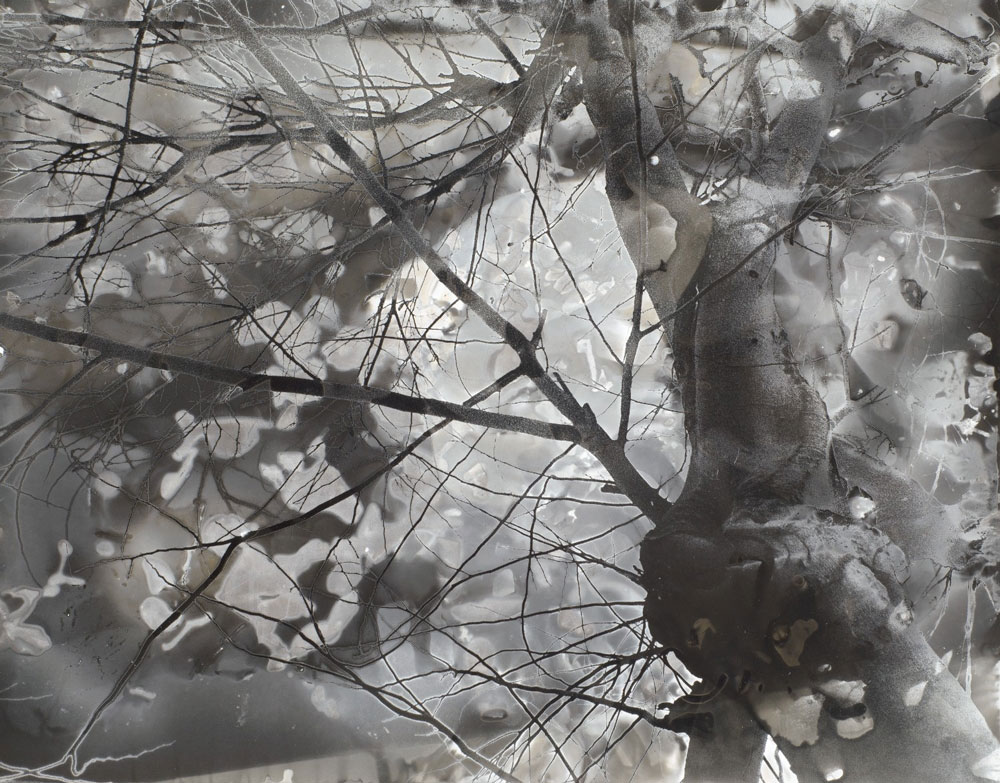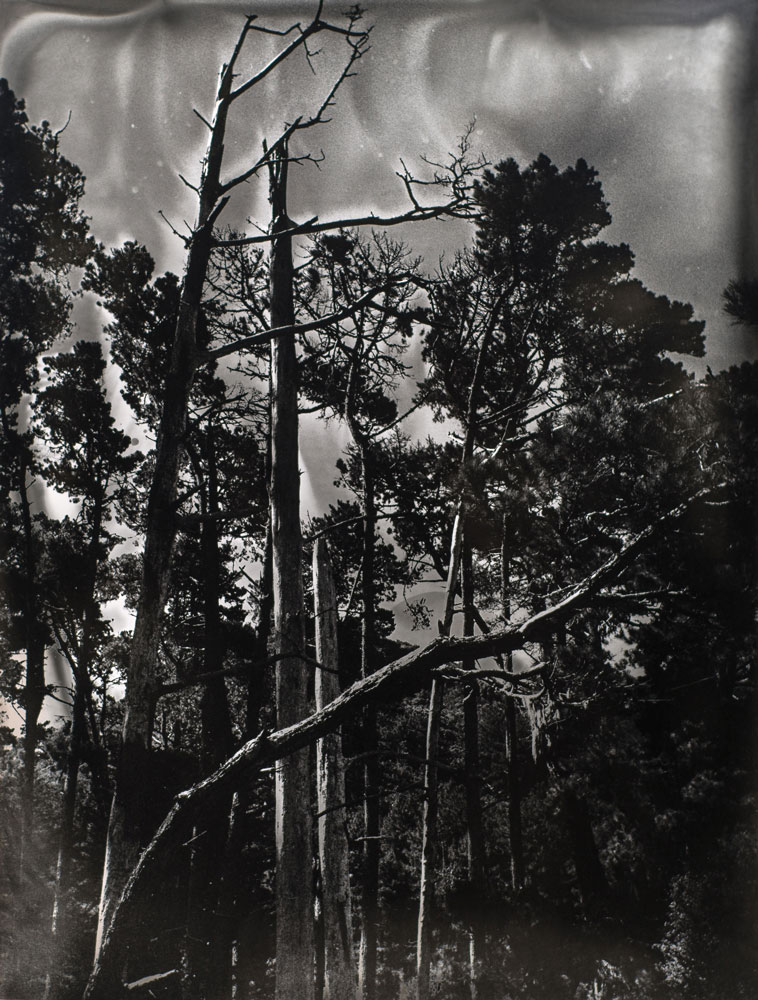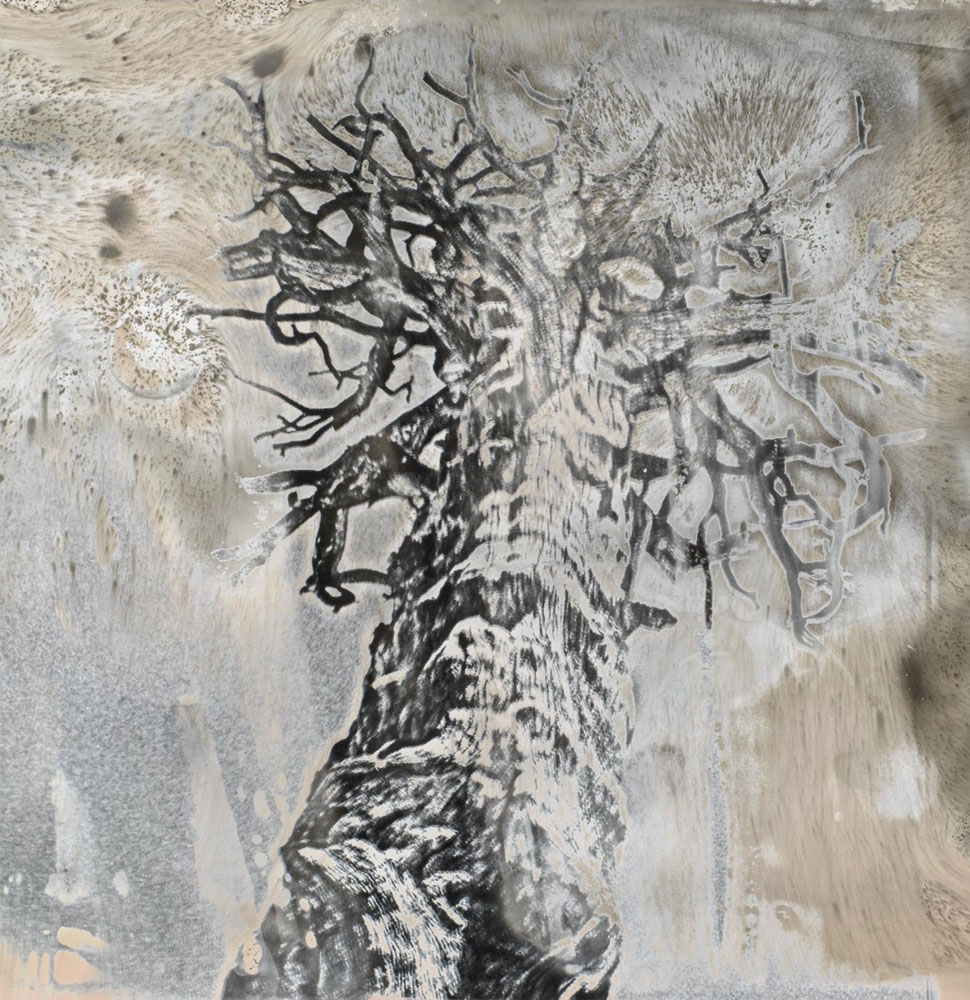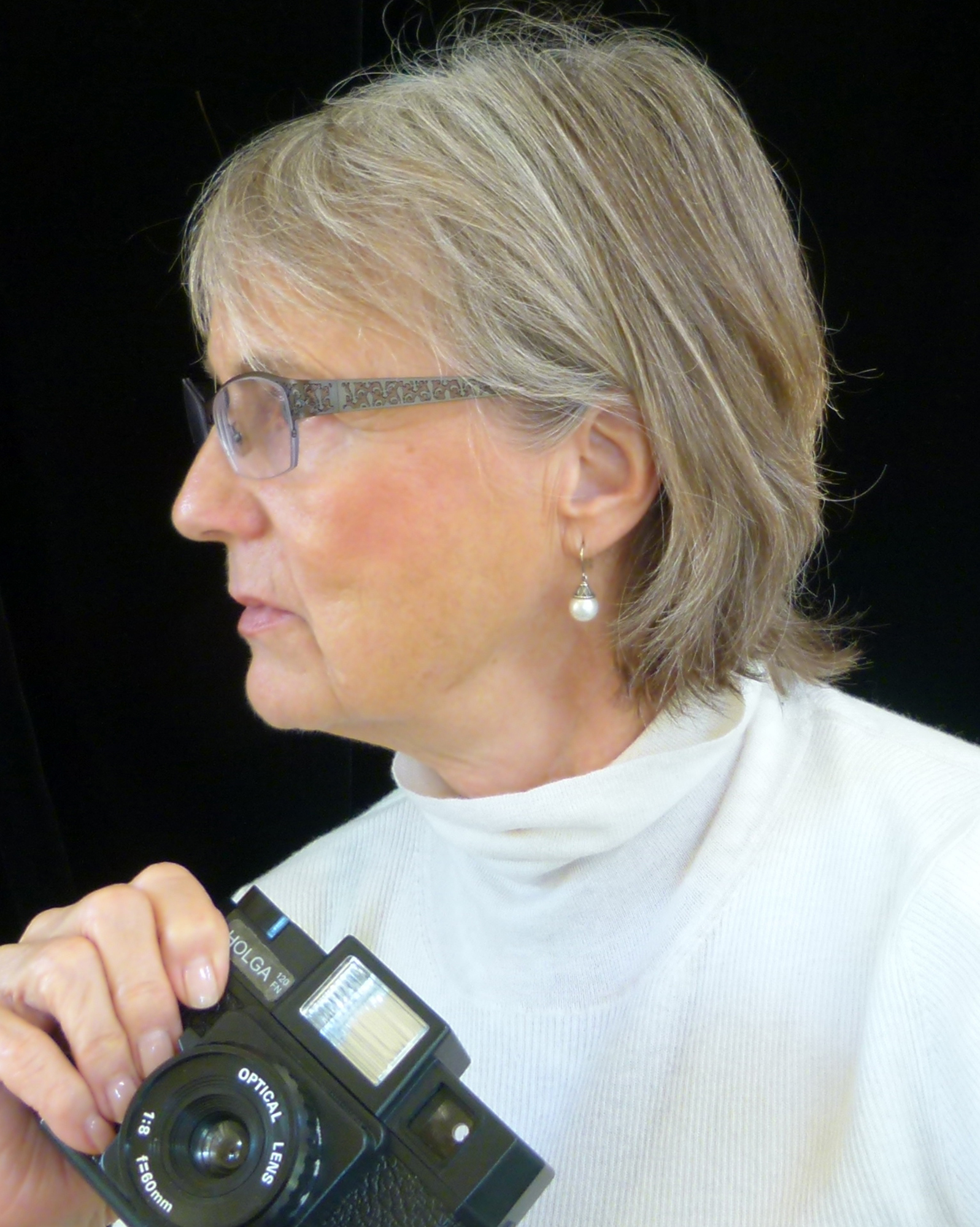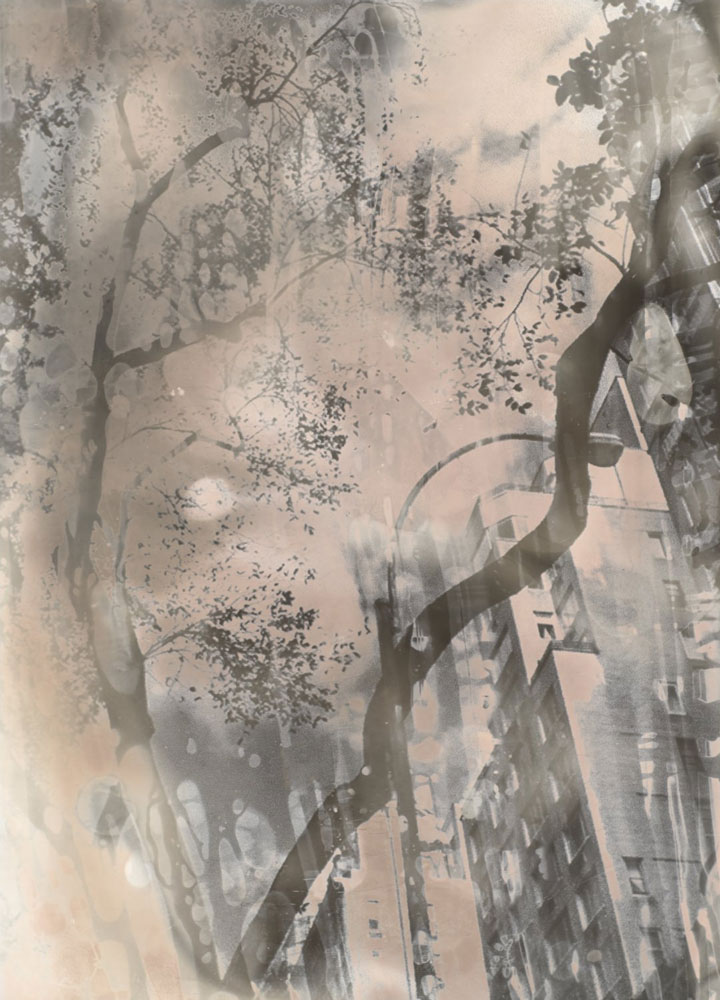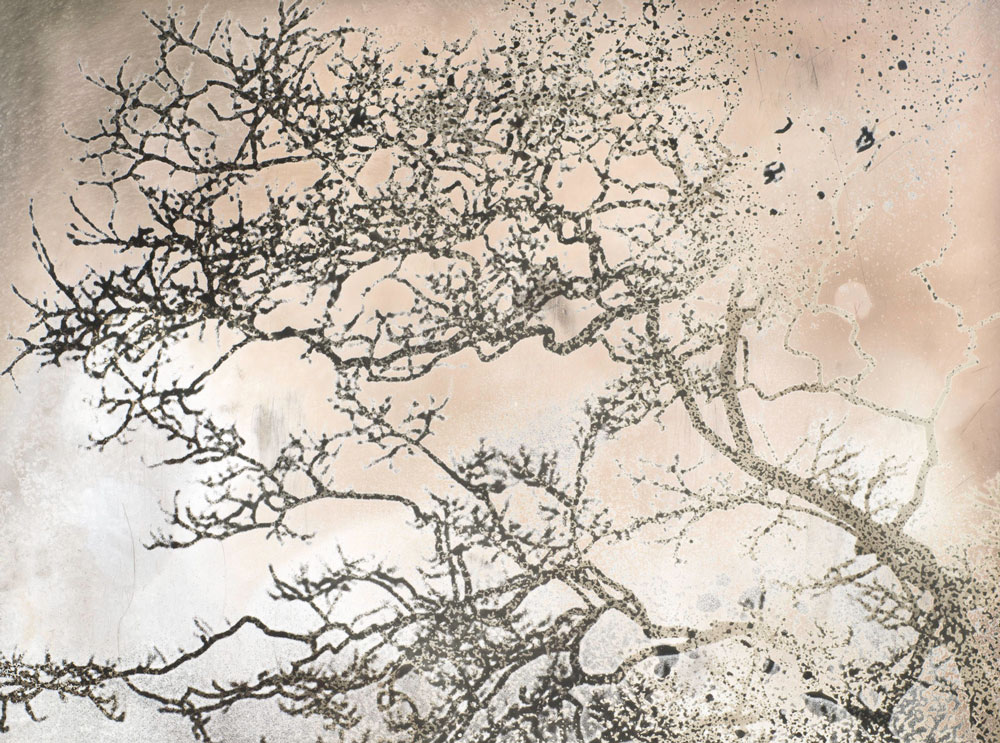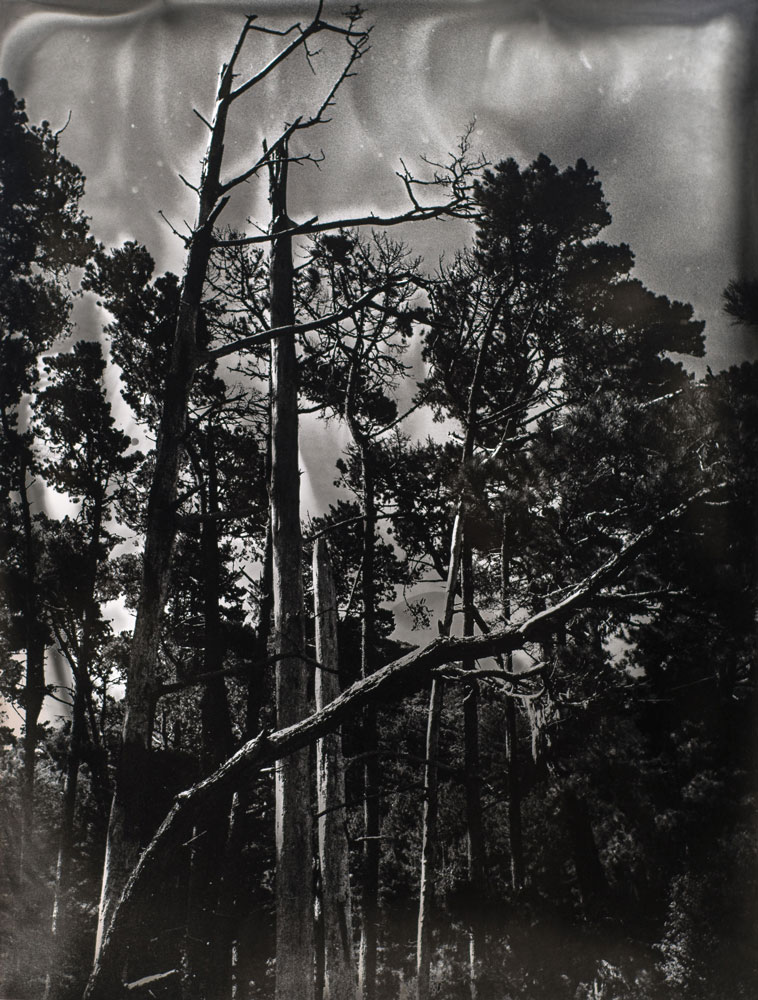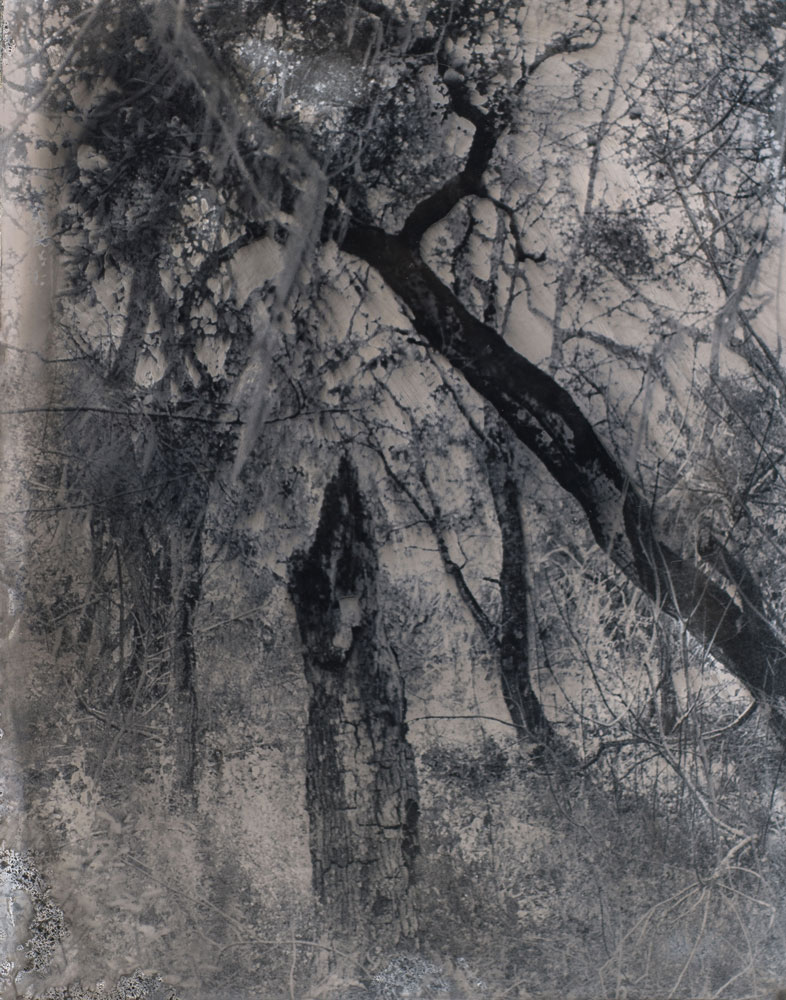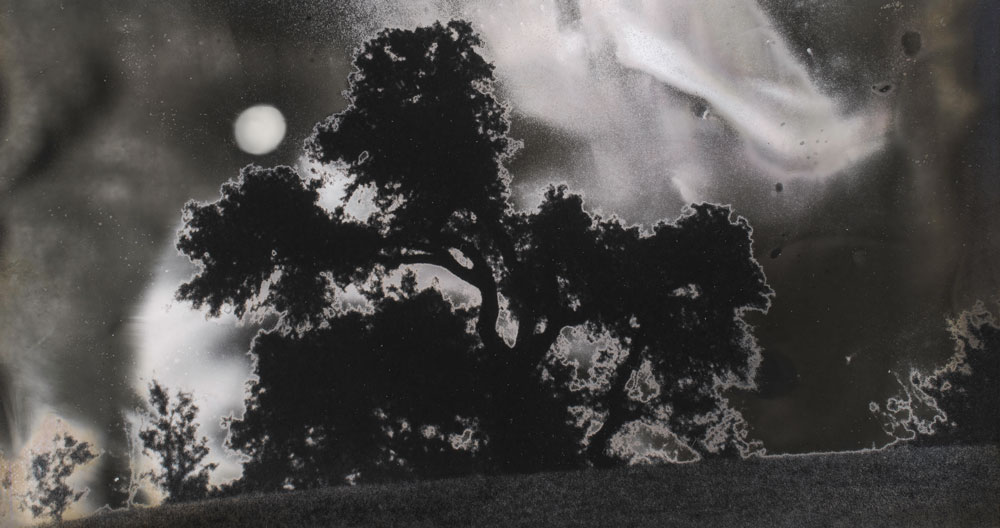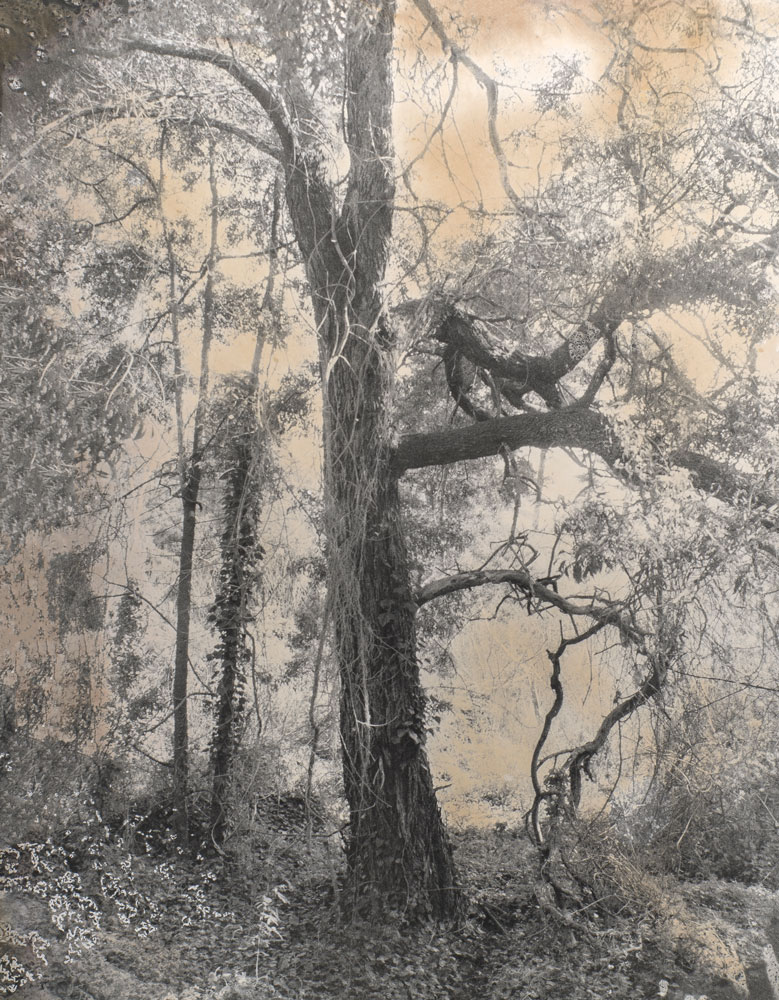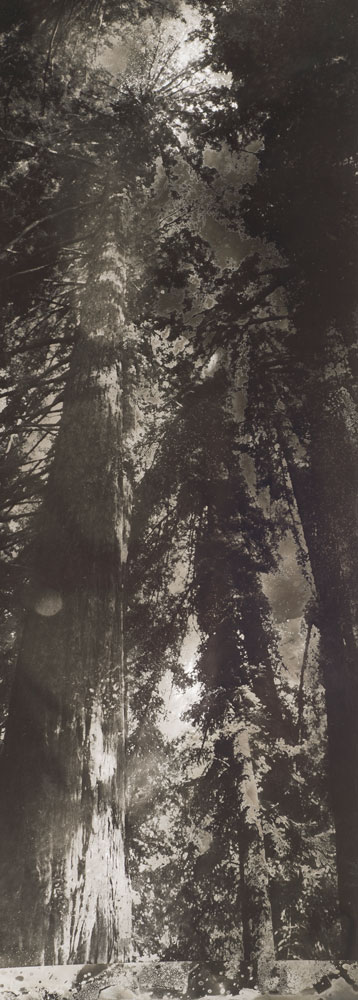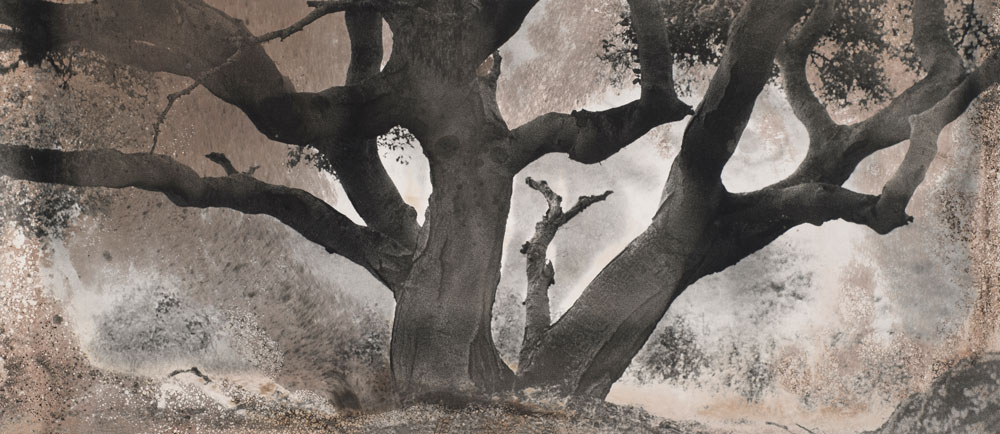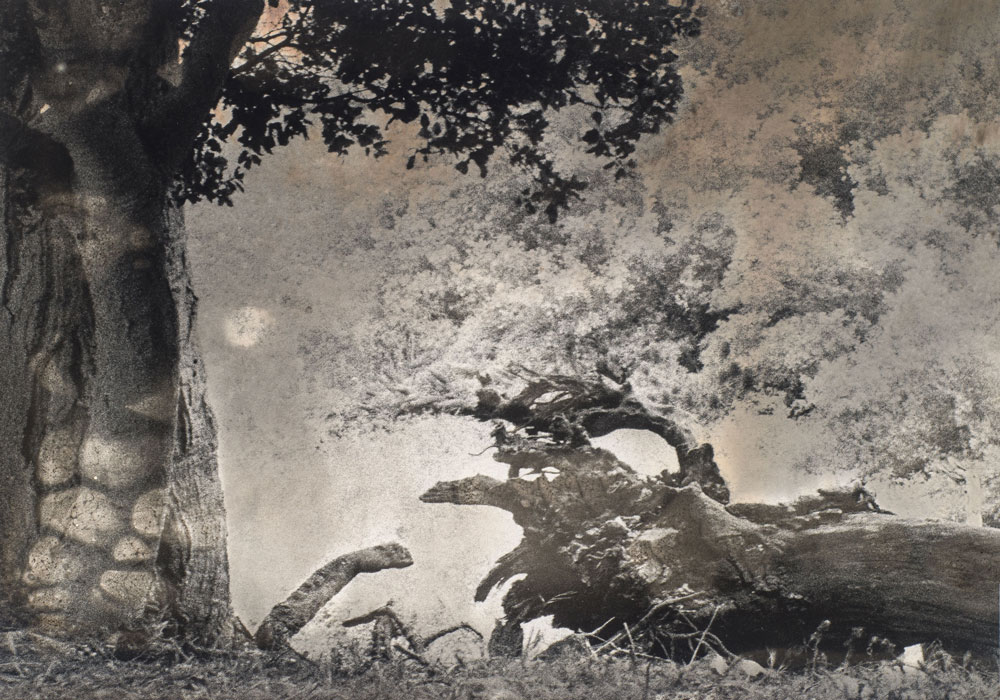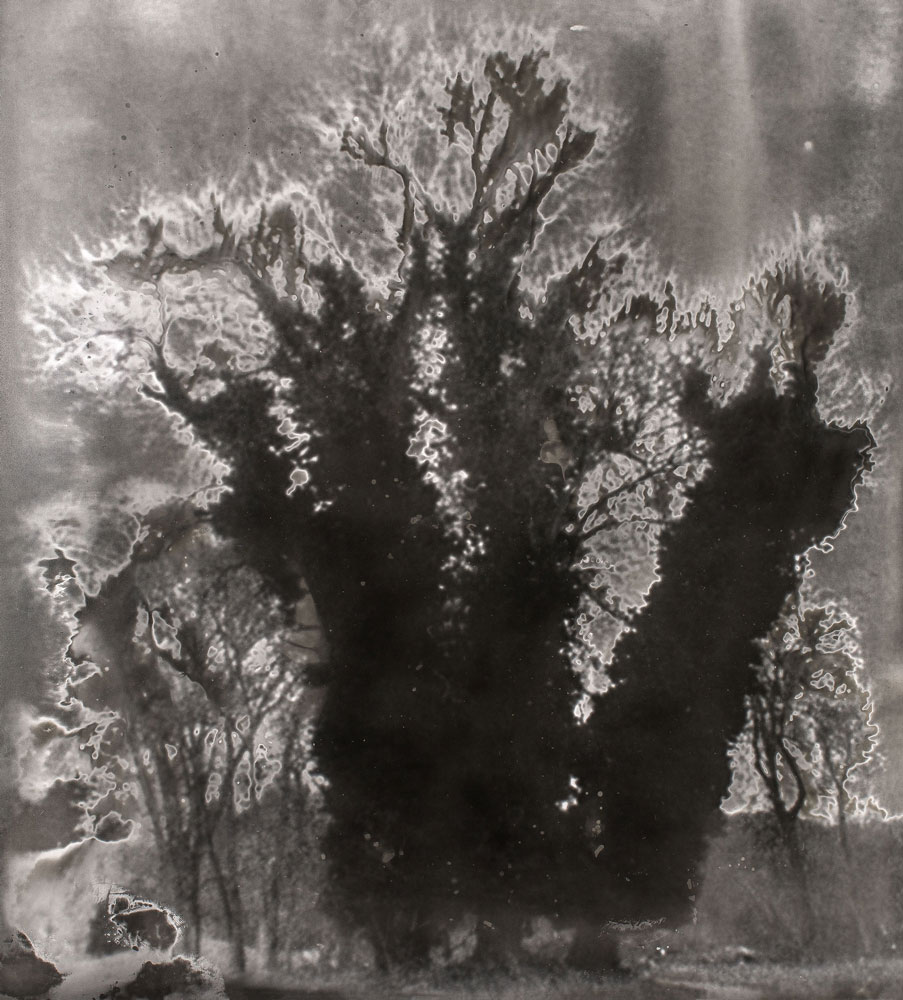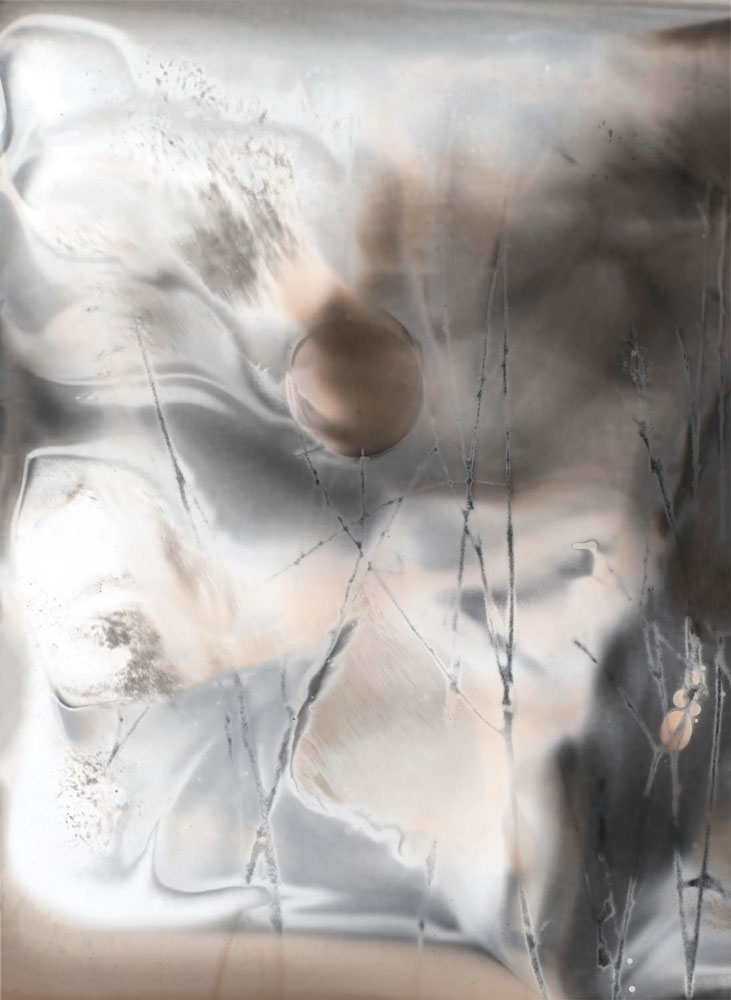Jane Olin: In the Company of Trees
Jane’s practice “reveals a fearless approach to printmaking, unorthodox, exciting and electric.”
– Ann Jastrab, Executive Director, Center for Photographic Art
Today, photographer Jane Olin opens a spectacular exhibition, In the Company of Trees, at the NUMU, the New Museum Los Gatos, that runs from January 14 to June 5, 2022. The exhibition, guest curated by Helaine Glick, will feature recent additions to her photography series, Intimate Conversation. Jane has a long legacy in the photographic arts in the Monterey Bay community, rich with photo history. She is a dedicated darkroom printer and has developed her own distinctive style that marries the natural world with the presence of the artist through intuition and chance. In our current landscape of digital and iphone capture, her work stands apart, through experimentation and the exploration of traditional photographic processes, and expands into a whole new language of expression. Jane brings a particular level of excellence and intelligence to her work.
Olin’s work will also be included in the Creative Center of Photography‘s exhibition, Trees Stir in Their Leaves, running January 22nd through July, 23, 2022. The Center for Creative Photography (CCP) and the Laboratory of Tree-Ring Research (LTRR) will stage installations together that follow historical, cultural, and scientific narratives inspired by trees. With more than 75 images and objects assembled from CCP and LTRR’s collections, trees stir in their leaves creates a multilayered experience with photography and dendrochronology (the study of annual rings in trees) in CCP’s Alice Chaiten Baker Interdisciplinary Gallery.
Olin’s photograph, Intimate Conversation 31, No Secret Here, 2021 is the January offering at the Center of Photographic Art’s Fine Art Program.
An interview with the artist follows.
“My photographs always begin with a question or some curiosity that arises within me. In more than twenty-five years, I have rarely photographed the external world for its own sake, but for the ways in which it helps to reveal subconscious processes and evoke meaning. I focus on a single subject in a related series of images, which allows me to hone in on the heart of what I am after. I also have a contemplative awareness practice that is of central importance to me, and which guides and enhances my working methods and my output.
As an adventurer who likes to experiment, I find that pushing the boundaries of what is possible with both camera and darkroom techniques motivates my best work. I photograph with film and often use a pinhole or Holga camera for making images. I enjoy the darkroom process and take advantage of every tool and technique at my disposal. Playing with exposure, focus, and a wide variety of photographic chemicals, I embrace creative accidents, and willingly abandon darkroom rules, with the intention of expressing a distinctive vision by whatever method seems right. I sometimes print my gelatin silver pieces digitally, but only after darkroom work is completed.”
Jane Olin has worked as a photographer in California’s Monterey Bay area for over thirty years. Living at the epicenter of West Coast photography, she learned the skills of “straight” photography and tenets of the historic Group f/64 from many of the assistants and students of Ansel Adams and Edward Weston. Since that time she has gone on to develop a distinctly personal vision, exploring the limits of focus and composition with a pinhole camera and darkroom enlarger, and over the last several years, with the gelatin silver developing process itself.
Raised in Steilacoom, overlooking Puget Sound in Washington State, Olin grew up surrounded by forests. She has traveled extensively, and is especially drawn to Japan–both its aesthetics and its Zen Buddhism. She maintains a mindfulness practice, and present moment awareness is embedded in her photographic process. Her choice of subject originates in internal questioning, personal experience, and often relies heavily on intuition. She works in series of related images, a method that allows for extended explorations of her subject.
Olin has actively exhibited her photography for many years. Her work has been the subject of group and solo exhibitions at the Monterey Museum of Art, Monterey, Triton Museum of Art, Santa Clara, Center for Photographic Art, Carmel, all in California. In 2022, she will be featured in a solo exhibition at NUMU, New Museum Los Gatos, CA, and a group exhibition at Center for Creative Photography, Tucson, AZ. She has won numerous juror awards, including a 2021 IPA International Photography Award Best of Show. Her work is held in the collections of Center for Creative Photography, Tucson, AZ, Museum of Photographic Arts, San Diego, Triton Museum of Art, Santa Clara, Crocker Museum of Art, Sacramento, and Monterey Museum of Art, Monterey, all in California. A lifelong champion of women in the arts, Olin founded Salon Jane, a women’s photography collective, in 2014.
My relationship with trees began in childhood, while playing under the majestic Douglas Firs near my home in the Pacific Northwest. I’ve loved trees ever since, so it was a natural progression to turn to them as a subject for my newest work, Intimate Conversation. I have also been inspired by the books The Hidden Life of Trees, by Peter Wohlleben and Finding the Mother Tree by Dr. Suzanne Simard. In these books, trees are revealed to create interdependent relationships through underground fungal networks, exchanging nutrients and chemical information in support of their seedling offspring and other neighboring trees. Working from this perspective, I strive to make images that invite deeper speculation into the nature of trees and that emphasize their individuality, complexity, and imposing presence. The world as we know it would not exist without them, and I want to convey this kinship in my work.
To create my photographs, I work in a traditional wet darkroom with negatives. I use chemicals in unorthodox ways, letting the developing process takes precedence over preconceived ideas. This technique gives me freedom to explore the limits of analog printing and take advantage of whatever chance events may occur. I have no interest in making or even enhancing images with a computer; the wet darkroom is where I thrive. It’s exhilarating (and at times challenging) to work in a liminal space that requires moment-by-moment and often intuitive decision-making. I enlarge and print my finished gelatin silver prints digitally—my sole nod to the digital revolution. For me, process printing means maintaining a fearless attitude towards an unknowable outcome and finding pleasure in creating in the moment. – Jane Orlin
You came to photography later in life, what was your previous career? (I believe we are the stew of all things in our lives).
My husband and I built a family-own business – over those years I raised our two children and worked as Marketing Manager for our company. We sold our company in 2019 after both of our children managed it for over 20 years after we retired. During those busy years of raising children and working for our company, I lost touch with who I was and what gave me joy. It happens to many women. So, when I retired my focus was finding out who I was, what my passion was and how I could enrich that passion.
Tell us about your early days in the darkroom.
I took my first darkroom class with Henry Gilpin, a protégé of Ansel Adams, and he taught the zone system for which I am grateful. I learned and used the basics of the zone system while studying at MPC (Monterey Peninsula College). There was very little emphasis on composition; during that era an example of an excellent photograph was one with a zone 7 highlight and a zone 3 shadow printed on high gloss paper. I studied with various photography teachers at MPC for several years. One day I decided I needed my own darkroom. By then, I knew that photography and being an artist was my passion. For many years, I used my converted furnace room as a darkroom and a little space next to it as my studio. With my own darkroom, I began pushing against the strict rules of traditional, f64 straight photography that I had learned at MPC. Examples of that are seen in my first series, Calla (1990’s), specifically Calla 1 and Calla 2, no zone 3 there. And I began using brown toned Agfa paper always mat never glossy paper. In addition, I began toning my prints sepia as seen in my Calla Series. I developed my own technique while using sepia toning baths downplaying the yellow tone that sepia tends toward and accentuating the brown. Much later, I developed a technique using both sepia and selenium toners, again leaning toward the brown tones.
Most importantly, I’ve always felt that most of my creative work happens in the darkroom. I loved to experiment and make a technique my own.
When was the shift in your darkroom artmaking from traditional to experimental?
My darkroom artmaking shifted from traditional rules most noticeable while making my Greta Series. I used a pinhole camera with a makeshift pinhole sized at the wrong dimension for the camera used. This made the pinhole images a little softer than it would have been with the right sized pinhole. I liked it. One late-night darkroom session, I forgot to refocus my enlarger after putting a new negative in it. Voila, the image was even softer and added an interesting boarder. I immediately knew that was the direction I would go in for this body of work. A good example of the unique boarder is Greta 10. This second body of work was completed in early 2000.
Over the years, I experimented and pushed against traditional darkroom procedure with every body of work. But the breakthrough for my current body of work came while working with negatives of dried plants against a wall. It resulted in my first body of work using process printing, Site Sight Unseen. (See artists statement for that work on my website for an explanation of process printing). You’ll find additional information about process printing, again on my website, by looking at my artist statement for Intimate Conversation.
You have such a profound connection to the natural world, do you spend a lot of time in nature?
I have a profound connection with the natural world through my love of trees.
I lived next to a forest of Douglas Fir trees until I was 3.5 years. My sister and I, she’s two years older than me, would venture out into the forest every day. My mother would tell us to go out to play and advised my sister, who was barely four to take care of me. I remember the magical days playing under the trees. My sister and I felt nurtured and safe under the protection of those majestic trees. In a way, those trees were my first companions and is the foundation for my love of trees.
For many years, I have walked in the forest of oaks in our regional park that is only five minutes away from where I live. And I also venture to Big Sur as often as I can to enjoy the company of Redwood trees. Trees still feel nurturing to me and now science tells us that trees release aerosols that benefit humans in many positive ways – the Japanese have known this long before science tells us of these things – they Forest Bath as often as possible. And this is what I do when I’m with the trees – I Forest Bath but I believe as little children my sister and I were forest bathing too.
What artists have inspired you over the years?
When I was a young woman working for our family-owned business, John and I traveled the U.S. and Europe for business. I never failed to go to as many museums and galleries as time permitted. But much to my dismay (and naiveite) there were few or no woman artists represented in those museum and galleries. Even in my art history course, which I loved, there were only one or two women artists represented (class was in late 60’s early 70’s). Not that I was even thinking at that time of being an artist, it still dismayed me and made me angry (always the feminist). Then in the early 80’s when John and I were in Washington DC (before the National Museum of Women in the Arts open their doors) I went to the National Gallery spending hours looking at art. I enjoyed myself but wondered where the women artists were. Again, very naïvely, I went to the information desk and asked where the women artists were? The young man told me that there were no women artists. From there I went on a search for women artist. a very long answer to your question is, l fell in love with Georgia O’keefe (and still absolutely love her art and her courageous life) and Immogen Cunningham. Not only do these two women create beautiful, memorable art, they withstood and overcame many obstacles. They still inspire me.
Can you share about your exhibition, In the Company of Trees, at the New Museum Los Gatos?
I am honored to be exhibiting at NUMU New Museum Los Gatos and am grateful to Ami Davis, Executive Director, and her staff for their support and for making working with them a joy. I am also grateful that my exhibition is up for five months. Helaine Glick has curated a beautiful exhibition and written beautiful essays for the exhibition and for my brochure. The work displayed In the Company of Trees reflects my on-going process work that I create in my darkroom. Process photography is innovative, challenging and requires a great deal of patience. But for me, the results are worth the hours in my darkroom. And besides that, I love darkroom work.
Tell us about Salon Jane!
Most artist work alone in their studios. I felt that I needed to bring together innovative artist whom I recognized in my community to support one another but also to critique and encourage one another. Monterey Peninsula is known for West Coast Photography inspired by Ansel Adam and others who promulgated the ideals of f64 and straight photography. I brought together 5 artist who are doing exciting, innovative work. We had our first meeting in 2014 and we have been meeting and exhibition together ever since. Pls. visit www.salonjane.com to see these artist innovative, beautiful work.
Are you still completely analog?
As stated early, most of my creative work happens in the darkroom. I make images using film. Early on when most of my colleagues were migrating toward digital, I said, “I’ll never go digital!” Well, I’ll never make a statement like that again because one never knows what the future will bring! In the end, my darkroom process work is a hybrid – analog/digital. When I made my first process image (a fortuitous gift) I instinctually knew that my little 8X10 gsp needed to be big. I do use the digital environment to print my work quite large but only after the darkroom work is finished. I never use photoshop. What you see is created in my darkroom.
So here I am using digital to my advantage but at the same time honoring my passion for creative darkroom work.
What’s next?
I have more images to make for my Intimate Conversation series. The series does not feel finished. I also have a hand-made book somewhere in my future. Intuitively I’m pushed in that direction and over the years, I’ve learned to listen to those impulses. I also want to go back to female portraits, pinhole probably, but with an edgy feel to them. Something that supports my feminist point of view.
Finally, describe your perfect day.
My perfect day always begins with my yoga practice, (40 years and counting) and my meditation practice after which I ask for deep guidance in my studio and for present moment awareness during the day. A day of no computer work only creative work in its many forms: thinking about what I want to do, writing, and finally the best working in my darkroom. Also throw in the mix a walk in the forest! What could be a better day…..
Posts on Lenscratch may not be reproduced without the permission of the Lenscratch staff and the photographer.
Recommended
-
Ragne Kristine Sigmond: Portraits of Painterly LightDecember 2nd, 2025
-
Mary Pat Reeve: Illuminating the NightDecember 1st, 2025
-
Ricardo Miguel Hernández: When the memory turns to dust and Beyond PainNovember 28th, 2025
-
Pamela Landau Connolly: Columbus DriveNovember 26th, 2025
-
MATERNAL LEGACIES: OUR MOTHERS OURSELVES EXHIBITIONNovember 20th, 2025

